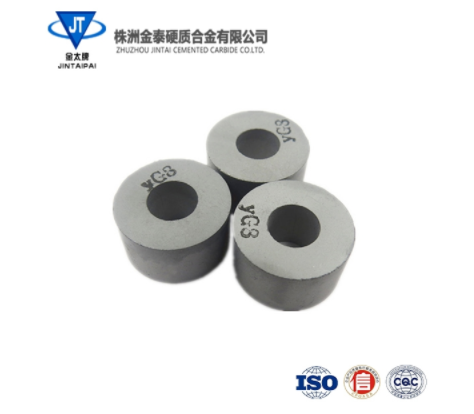The cemented carbide mold places the tubular parison, which is still in the plasticized state, obtained by extrusion or injection, into the mold cavity while it is hot, and immediately passes compressed air through the center of the tubular parison, causing the mold to expand and become tightly attached. On the wall of the mold cavity, a hollow product can be obtained after cooling and solidification. The mold used in this plastic product molding method is called a hollow blow mold. Hollow blow molding molds are mainly used for molding hollow container products made of thermosetting plastics.
Carbide mold air pressure forming mold is usually composed of a single female mold or male mold. Press the periphery of the pre-prepared plastic sheet tightly against the periphery of the mold and heat it to soften it. Then vacuum the side close to the mold, or fill the opposite side with compressed air to make the plastic sheet close to the mold. After cooling and shaping, a thermoformed product is obtained. The mold used for molding such products is called a pneumatic mold.
Carbide mold production and manufacturing technology concentrates the essence of mechanical processing. It is both mechanical and electrical combined processing and is inseparable from the operation of the mold fitter. Its characteristics are as follows:
(1) Process characteristics of mold production: After a set of molds is produced, hundreds of thousands of parts or products can be produced through it. However, the mold itself can only be produced as a single piece. The products of mold companies are generally unique, and there is almost no repeated production. This is a significant difference between mold companies and other companies.
(2) Characteristics of mold manufacturing Since the mold is produced in a single piece, the accuracy requirements are higher than the product accuracy requirements. Therefore, there are many unique features in manufacturing. ① Mold manufacturing requires relatively high technical level of workers. ②The production cycle of cemented carbide molds is longer than that of ordinary products and the cost is higher. ③In the process of manufacturing molds, there are many processing contents in the same process, so the production efficiency is low. ④ During mold processing, the position and size of certain working parts should be determined through testing. ⑤After assembly, the mold must be tried out and adjusted. ⑥Mold production is a typical single-piece production. Therefore, the production process, management method, mold manufacturing process, etc. all have unique adaptability and rules. ⑦ Complex shape and high manufacturing quality requirements. ⑧The material has high hardness. ⑨Mold processing is developing towards mechanization, precision and automation.
Carbide molds are used for continuous extrusion of plastic profiles, commonly known as extrusion molds, also known as extrusion heads. This is another large category of plastic molds with a wide range of uses and varieties. Mainly used for the molding and processing of plastic rods, pipes, plates, sheets, films, wire and cable coatings, mesh materials, monofilaments, composite profiles and special profiles. It is also used for the molding of hollow products. This type of mold is called a parison mold or a parison head.
Product parts have increasingly higher requirements for the precision of carbide molds, and there are more and more molds with high precision, long life, and high efficiency. At present, the use of precision molding grinders, CNC high-precision surface grinders, precision CNC wire-cut electric discharge machine tools, high-precision continuous trajectory coordinate grinders and three-dimensional coordinate measuring instruments is becoming more and more common, making mold processing more technology-intensive.
Post time: Oct-25-2024













